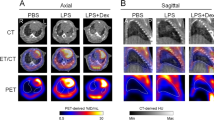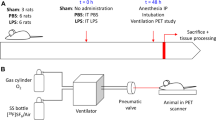Summary
The establishment of a small animal model for studies of lung injury is in great demand. Therefore, a double radioisotope labeling method was applied to study the dynamics of lung injury with protein-rich edema in the anesthetized guinea pig. One external scintillation detector was placed over the lung and another over the heart, where they continuously sampled the energy spectrum of113Inm labeled transferrin, a macromolecular marker, and99Tcm labeled red blood cells (RBC), a blood pool marker. Lung injury was induced by i.v. oleic acid in doses of 0.03 and 0.06 ml/kg b.wt. infused for 10 min. We calculated the rate of increase of accumulated113Inm-transferrin in the lung corrected for blood pool changes. Macromolecular leakage showed a graded response in regression line-slope (RLS) to oleic acid. Both oleic acid groups showed significantly different RLSs as compared to the saline control (mean ± SD × 10−3 min−1; 0.03 ml: 3.86 ± 1.01 (n = 7); 0.06 ml: 10.75 ± 4.06 (n = 6), and control 1.12 ± 1.19 (n = 6)). Assays of changes of acid-base balance, cell dynamics, and lung wet-dry weight were in accordance with the occurrence of lung edema. The RLS was well correlated with the lung wet-dry weight (r = 0.98). We conclude that measurements of pulmonary edema in guinea pigs can be performed quantitatively with the aid of external detection of radiolabeled transferrin and RBC:s. Thus, the method could be useful in further studies on mechanisms and/or treatment of protein-rich lung edema.
Similar content being viewed by others
References
Basran GS, Byrne AG, Hardy JG (1985) A noninvasive technique for monitoring lung vascular permeability in man. Nucl Med Commun 3:3–10
Baughman RP, Stein E, MacGee J, Rashkin M, Sahebjami H (1984) Changes in fatty acids in phospholipids of the bronchoalveolar fluid in bacterial pneumonia and in adult respiratory distress syndrome: Clin Chem 30:521–523
Brigham KL, Meyrick B (1986) Endotoxin and lung injury. Am Rev Respir Dis 133:913–927
Dauber IM, Pluss WT, VanGrondelle A, Trow RS, Weil JV (1985) Specificity and sensitivity of noninvasive measurement of pulmonary vascular protein leak. J Appl Physiol 59:564–574
Erjefält IAL, Wagner ZG, Strand SE, Persson CGA (1985) A method for studies of tracheobronchial microvascular permeability to macromolecules. J Pharmacol Methods 14:275–283
Gorin AB, Weidner WJ, Demling RH, Staub NC (1978) Noninvasive measurement of pulmonary transvascular protein flux in sheep. J Appl Physiol 45:225–233
Gorin AB, Weingarten J, Leblanc A, Stevens P (1982) External radioflux detection: Noninvasive measurement of protein leakage in assessing lung microvascular injury. Ann N Y Acad Sci 384:411–416
Hambrecht GS, Hilton JG (1984) A modified technique for permeability studies in the superfused hamster cheek pouch. Life Sci 34:971–976
Hofman WF, Ehrhart IC, Granger WM, Miller DA (1985) Sequential cardiopulmonary changes after oleic-acid injury in dogs. Crit Care Med 13:22–27
Hultkvist U, Westergren G, Hansson UH, Lewan L (1987) Effects of pH on the stability of the Indium-113 m blood protein complex and the selective binding of Indium-113 m to transferrin. Res Exp Med 187:131–137
Korubin V, Maisey MN, McIntyre PA (1972) Evaluation of technetium-labeled red cells for determination of red cell volume in man. J Nucl Med 13::760–762
Montaner JSG, Tsang J, Evans KG, Mullen JBM, Burns AR, Walker DC, Wiggs B, Hogg JC (1986) Alveolar epithelial damage. A critical difference between high-pressure and oleic acid-induced low-pressure pulmonary edema. J Clin Invest 77:1786–1796
Mårtensson L, Davidsson B, Hultkvist U (1988) The guinea pig as an animal model in shock-induced by endotoxins. Int J Microcirc: Clin Exp (in press)
Snapper JR, Brigham KL (1986) Pulmonary edema. Hosp Pract 21:87–101
Sugerman HJ, Strash AM, Hirsch JI, Glauser FL, Shirazi KK, Sharp DE, Greenfield LJ (1981) Sensitivity of scintigraphy for detection of pulmonary capillary albumin leak in canine oleic acid ARDS. J Trauma 21:520–552
Tatum JL, Strash AM, Sugerman HJ, Hirsch JI, Beachley MC, Greenfield LJ (1981) Single isotope evaluation of pulmonary capillary protein leak (ARDS model) using computerized gamma scintigraphy. Invest Radiol 16:473–478
Taylor A, Townsley MI, Korthuis RJ (1985) Macromolecule transport across the pulmonary microvessel walls. Exp Lung Res 8:97–123
Welsh CH, Dauber IM, Weil JV (1986) Endotoxin increases pulmonary vascular protein permeability in the dog. J Appl Physiol 61:1395–1402
Zelter M, Douguet D (1986) Experimental pulmonary oedemas. Bull Eur Physiopathol Respir 22:281–314
Author information
Authors and Affiliations
Additional information
Supported by the Hierta-Retzius Foundation, the Crafoordska Foundation and Gambro AB
Rights and permissions
About this article
Cite this article
Hultkvist, U., Bjellin, L. & Mårtensson, L. External113Inm and99Tcm radiation detection of lung edema induced by oleic acid in the guinea pig. Res. Exp. Med. 188, 277–288 (1988). https://doi.org/10.1007/BF01852276
Received:
Accepted:
Issue Date:
DOI: https://doi.org/10.1007/BF01852276




